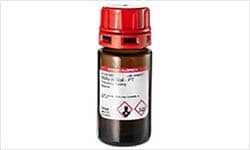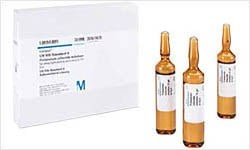Gas Chromatography (GC)

Gas chromatography (GC) is a common analytical technique used to separate and analyze volatile and semi-volatile compounds in a mixture. GC is a popular analytical technique as it combines exceptional resolving power with speed and sensitivity. It is widely applied in many industries, including environmental, petroleum, chemical, food and beverage, and pharmaceutical
Like other forms of chromatography, GC involves a stationary phase and a mobile phase. In GC, the mobile phase is an inert gas, usually helium or nitrogen, and the stationary phase is either a solid adsorbant, termed gas-solid chromatography (GSC), or a liquid adsorbed onto an inert support, termed gas-liquid chromatography (GLC, or just GC).
Related Articles
- AOCS and AOAC methods for determining the trans fatty acid composition of foods by gas chromatography require the use of a highly polar cyanosilicone capillary column to provide the best peak resolution attainable of the numerous geometric (cis & trans) and positional isomers.
- We provide high-quality, relevant hopane reference standards to be used as biomarkers for petrochemical oil field remediation and spill analysis.
- This is an article concerning P-I-A-N-O standards for detailed hydrocarbon analyses.
- Understanding the boiling point range distribution of petrochemical products is critical for selection of the proper method to process feed stocks, for process control, for contaminant identification and for development of new test methods.
- SLB®-ILPAH is a special purpose column based on an ionic liquid stationary phase providing unique selectivity and efficient column dimensions allowing exceptional resolution of PAHs
- See All (57)
Related Protocols
- Last year, the International Fragrance Association (IFRA) published a new method for the testing of 57 potentially allergenic fragrances. We introduce two new dedicated certified reference materials (CRMs) and their analysis by GC using an ionic liquid capillary column, providing unique selectivity & stability.
- Alkylphenols are starting materials for the synthesis of alkylphenol ethoxylates, which are widely used as non ionic tensides, dispersive agents in paper and leather manufacturing, emulsifiers for pesticide formulations and as auxiliary agents for drilling and flotation.
- AOCS and AOAC methods for determining the trans fatty acid composition of foods by gas chromatography require the use of a highly polar cyanosilicone capillary column to provide the best peak resolution attainable of the numerous geometric (cis & trans) and positional isomers.
- Aldehydes and ketones are ubiquitous air pollutants. Along with esters and ethers, they are major components of indoor air pollution and are therefore important for industrial hygiene applications.
- An article regarding A New GC-MS Method for Mycotoxin Analysis Using 13C-marked Mycotoxin Derivatives from Sigma-Aldrich.com
- See All (158)
How does gas chromatography work?
After sample collection and preparation, the analytes of interest are separated inside the column and then a detector measures the quantity of the components that exit the column. In GC, an analyte is injected into the instrument’s sampling port and enters an oven where it is vaporized. The vaporized sample is transported through a chromatographic column by the flow of inert gas that forms the mobile phase. Compounds in the sample partition between the column’s stationary phase and the carrier gas. The strength of compound-stationary phase interaction determines an analyte’s retention time. At the column’s outlet, a detector (MS or non-MS) creates a signal when compounds pass by. A chromatogram is the result of a GC separation.
To measure the concentration of a test sample, a standard sample with known concentration is injected into the GC instrument. The peak retention time and area of the standard is compared to the test sample’s results to determine the unknown concentration. In GC, external and internal standards are commonly employed in order to ensure reliable quantification of the test sample. When known standards are run separately from the actual sample of interest and the response is compared to that of the sample in another chromatogram, it is referred to as an external standard. When the standard is added to the sample and analyzed simultaneously, it is called an internal standard.
Sample Collection and Preparation for GC analysis
Many samples can be analyzed by GC so long as the compounds are reasonably volatile (can be vaporized) yet are thermally stable (do not degrade at high temperature). Samples can be collected from solid, liquid, or gaseous materials. When preparing samples for GC, it’s important to minimize sample complexity because the quality of the sample impacts the accuracy and precision of your final chromatographic results. A wide variety of matrix-specific sample preparation techniques are available to help isolate and concentrate analytes and sample matrices prior to GC analysis.
How to choose a GC column
The GC column is the heart of a GC system, where chromatographic separation occurs. Selecting the proper GC column should be based on 4 significant factors: stationary phase, column internal diameter (I.D.), film thickness, and column length. These factors impact column efficiency, resolution and sample capacity.
The stationary phase should be selected based on the application to be performed.
Gas Chromatography (GC) Workflow Solutions
To continue reading please sign in or create an account.
Don't Have An Account?


